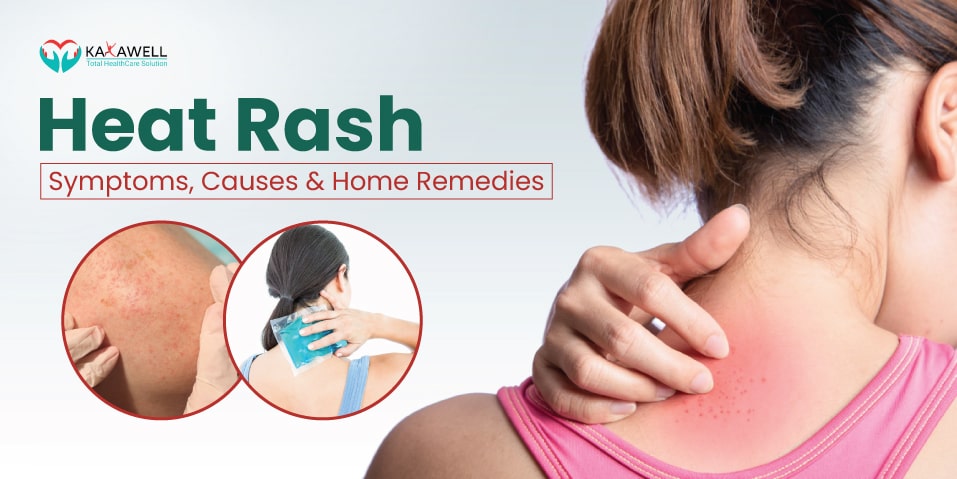What Is Heat Rash?
Heat rash, also known as miliaria, prickly heat which is a common condition, in which areas of the skin feel prickly or sting because of overheating. It is very itchy but it cannot be dangerous.
This looks like small bumps of red skin around them. This usually happens on your body’s covered parts, such as your back, belly, arms, upper chest, groin, or armpits. And it typically gets better when your skin cools off.
In dry, humid conditions, heat rash occurs most frequently. It is most common in infants. It’s also more likely to get active men, newborns in incubators, and men on the bed who rest with fever.
What are the symptoms of heat rash?
Symptoms of Heat Rash:
- Tiny, pink bumps
- Mainly on the neck, chest and upper back
- Occurs during hot, humid weather or after lots of suns
- An irritating itch and prickling sensation
- Older children may have a “prickly” pins and needles feeling
- The rash may have some small water blisters, in infants
- No fever or illness
- Also called “prickly heat
When should you call your doctor?
Heat rash is rarely serious. Often it goes away without treatment in a few days. However, you should call your doctor if you begin to experience:
- A fever
- Chills
- Increased pain
- Pus draining from the bumps
Call your child’s doctor if your child has a heat rash and it doesn’t go away in a few days. Your doctor may recommend that you apply lotions such as calamine or lanolin to relieve itching and prevent further damage. Hold cool and dry on their skin to help reduce heat rash.
What Are the Causes?
The principal cause of heat rash is blocked sweat glands. Sweat glands can get blocked for many reasons but the most common reasons include:
- Skin around the neck, armpit, or groin that touches or rubs adjacent skin prevents sweat evaporation.
- Tight clothing around the waist, abdomen, chest, or groin that prevents evaporation of sweat.
- Bundling into heavy clothes where sweat can build up on the skin.
- Heavy creams, oily lotions, or adhesive bandages can clog sweat ducts.
What are the risk factors for heat rash?
Several factors increase the risk of heat rash. Not everybody who has risk factors gets heat rash. Risk factors for heat rash include:
- Excessive sweating
- Hot, humid environments
- Prolonged periods of inactivity, which permit sweat to collect and become trapped
- Tight, constricting clothing that does not permit the skin to “breatheâ€
Complications
Rarely, heat rash can become infected with bacteria. This makes the fluid-filled bumps painful, bigger, and more inflamed.
A very rare complication of heat rash is heat exhaustion. If your child’s sweat ducts are clogged, the body cannot cool itself properly. Untreated heat exhaustion can lead to heatstroke. This is a dangerous illness that can lead to organ damage or death. When the body of the child creates more heat than it can release the heatstroke happens. The child’s core body temperature increases rapidly, to 40°C or higher.
Home Remedies for Heat Rash
Yoghurt:
Yoghurt has been known to have both, a cooling and soothing effect on the skin. Apply cold yoghurt to the affected areas and leave it on for 15 minutes. Wash with cold water and pat dry. Never rub the irritated skin. Yoghurt can help prevent the breakout of acne and ensure glowing and healthy skin.
Rose Water:
Make a concoction using the following ingredient: 200ml rose water, 4 Tbsp honey, and 200ml pure water. Mix and freeze in an ice tray. Take four to five these ice cubes, and wrap them in a soft cloth. Press the bundle gently on the affected areas. Rosewater maintains the pH balance of the skin and also controls excess oil.
Prefer to wear loose cotton clothing:
Loose clothes allow air to circulate the body, keeping it cool. Wearing lightweight, such as cotton or natural fabrics, instead of synthetic, will also help you to prevent from heat rash.
Baking soda:
Baking soda (sodium bicarbonate) can soothe itchy skin. It’s also something most of us have in our pantry. This is an effective and great home remedy to prevent heat rash and other itchy skin conditions.
Add 3 to 5 tablespoons of baking soda to a lukewarm bath and soak for about 20 minutes.
Aloe Vera:
Aloe Vera has many medicinal properties, and the gel has strong anti-inflammatory effects. People may find that applying aloe Vera gel onto a heat rash can help to ease the irritated skin.
Prevention
Here are some tips which help you to prevent heat rash:
- Avoid overdressing. In summer, wear soft, lightweight, cotton clothing. Children should dress as warmly as an adult in winters.
- Avoid tightfitting clothes that can irritate the skin.
- Through the cold therapy, Keep the affected areas of the skin cool.
- Keep your sleeping area cool and well-ventilated.
- Use non-drying soap without fragrances or dyes

Leave a Reply
You must be logged in to post a comment.